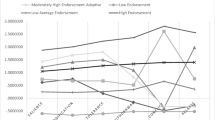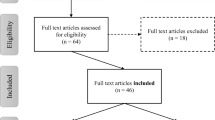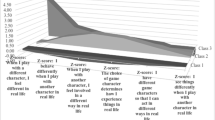Abstract
The Substance Use Risk Profile Scale (SURPS) identifies four personality dimensions related to reinforcement-specific patterns of substance use. Gaming literature has identified similar personalities and game-related reinforcement properties as core risk factors of problematic play. Given similarities, we investigated whether the SURPS model could be confirmed in a recreational video game playing population as a predictive model of problematic gaming. We recruited participants through gaming forums and Amazon Mechanical Turk to complete an online survey that focused on the SURPS and indicators of problematic gaming. Confirmatory factor analysis indicated that the SURPS is a valid instrument measuring four distinct personality dimensions with minor modifications. Regression analyses did not confirm all four at-risk personality dimensions as predictors of problematic play. The Impulsive personality was a significant predictor of lifetime frequency and problematic gaming, whereas the Hopelessness personality was a significant predictor of time spent playing. Future studies will need to assess this model using outcome variables grouped based on reinforcement-related gaming taxonomy.
Similar content being viewed by others
References
American Psychiatric Association. DSM-5 Task Force. (2013). Diagnostic and statistical manual of mental disorders: DSM-5™. Arlington, VA, US.
Arnett, J. J. (2005). The developmental context of substance use in emerging adulthood. Journal of Drug Issues, 35(2), 235–254. https://doi.org/10.1177/002204260503500202
Blanchard, B. E., Stevens, A. K., Sher, K. J., & Littlefield, A. K. (2020). Reexamining the psychometric properties of the Substance Use Risk Profile Scale. Assessment, 27(3), 454–471.
Byrne, B. M. (2009). Structural equation modeling with AMOS: Basic concepts, applications, and programming. Routledge.
Castellanos-Ryan, N., O’Leary-Barrett, M., Sully, L., & Conrod, P. (2013). Sensitivity and specificity of a brief personality screening instrument in predicting future substance use, emotional, and behavioral problems: 18-month predictive validity of the Substance Use Risk Profile Scale. Alcoholism: Clinical and Experimental Research, 37, 281–290.
Castellanos-Ryan, N., Brière, F. N., O’Leary-Barrett, M., Banaschewski, T., Bokde, A., Bromberg, U., … Garavan, H. (2016). The structure of psychopathology in adolescence and its common personality and cognitive correlates. Journal of Abnormal Psychology, 125(8), 1039.
Chumbley, J., & Griffiths, M. (2006). Affect and the computer game player: The effect of gender, personality, and game reinforcement structure on affective responses to computer game-play. Cyberpsychology & Behavior, 9(3), 308–316.
Cole, H., & Griffiths, M. D. (2007). Social interactions in massively multiplayer online role-playing gamers. Cyberpsychology & Behavior, 10(4), 575–583.
Conrod, P. J., Pihl, R. O., & Vassileva, J. (1998). Differential sensitivity to alcohol reinforcement in groups of men at risk for distinct alcoholism subtypes. Alcoholism: Clinical and Experimental Research, 22(3), 585–597.
Conrod, P. J., Pihl, R. O., Stewart, S. H., & Dongier, M. (2000). Validation of a system of classifying female substance abusers on the basis of personality and motivational risk factors for substance abuse. Psychology of Addictive Behaviors, 14(3), 243.
Coyne, S. M., Stockdale, L. A., Warburton, W., Gentile, D. A., Yang, C., & Merrill, B. M. (2020). Pathological video game symptoms from adolescence to emerging adulthood: A 6-year longitudinal study of trajectories, predictors, and outcomes. Developmental Psychology, 56(7), 1385.
Deci, E. L., & Ryan, R. M. (2000). The “what” and “why” of goal pursuits: Human needs and the self-determination of behavior. Psychological Inquiry, 11, 227–268.
Elliott, L., Golub, A., Ream, G., & Dunlap, E. (2012). Video game genre as a predictor of problem use. Cyberpsychology, Behavior, and Social Networking, 15(3), 155–161.
Esposito, M. R., Serra, N., Guillari, A., Simeone, S., Sarracino, F., Continisio, G. I., & Rea, T. (2020). An investigation into video game addiction in pre-adolescents and adolescents: A cross-sectional study. Medicina, 56(5), 221.
Gossop, M., Darke, S., Griffiths, P., Hando, J., Powis, B., Hall, W., & Strang, J. (1995). The Severity of Dependence Scale (SDS): Psychometric properties of the SDS in English and Australian samples of heroin, cocaine and amphetamine users. Addiction, 90(5), 607–614.
Griffiths, M. D. (2010). The role of context in online gaming excess and addiction: Some case study evidence. International Journal of Mental Health and Addiction, 8(1), 119–125
Hu, L. T., & Bentler, P. M. (1999). Cutoff criteria for fit indexes in covariance structure analysis: Conventional criteria versus new alternatives. Structural Equation Modeling: a Multidisciplinary Journal, 6(1), 1–55.
Jurk, S., Kuitunen‐Paul, S., Kroemer, N. B., Artiges, E., Banaschewski, T., Bokde, A. L., ... & Frouin, V. (2015). Personality and substance use: Psychometric evaluation and validation of the Substance Use Risk Profile Scale (SURPS) in English, Irish, French, and German adolescents. Alcoholism: Clinical and Experimental Research, 39(11), 2234–2248.
King, D. L., Herd, M. C., & Delfabbro, P. H. (2018). Motivational components of tolerance in internet gaming disorder. Computers in Human Behavior, 78, 133–141.
Koob, G. F. (2004). Allostatic view of motivation: Implications for psychopathology. Nebraska Symposium on Motivation, 50, 1–18.
Krank, M., Stewart, S. H., O’Connor, R., Woicik, P. B., Wall, A. M., & Conrod, P. J. (2011). Structural, concurrent, and predictive validity of the Substance Use Risk Profile Scale in early adolescence. Addictive Behaviors, 36(1–2), 37–46.
Kuss, D. J., & Griffiths, M. D. (2012). Internet gaming addiction: A systematic review of empirical research. International Journal of Mental Health and Addiction, 10(2), 278–296
Moberg, D. P. (2003). Screening for alcohol and other drug problems using the Adolescent Alcohol and Drug Involvement Scale (AADIS). Center for Health Policy and Program Evaluation, University of Wisconsin-Madison.
Morris, E. P., Stewart, S. H., & Ham, L. (2005). The relationship between social anxiety disorder and alcohol use disorders: A critical review. Clinical Psychology Review, 25, 734–760.
Na, E., Choi, I., Lee, T. H., Lee, H., Rho, M. J., Cho, H., … Kim, D. J. (2017). The influence of game genre on internet gaming disorder. Journal of Behavioral Addictions, 6(2), 248–255.
Petry, N. M. (2006). Should the scope of addictive behaviors be broadened to include pathological gambling? Addiction, 101, 152–160.
Petry, N. M., & O’Brien, C. P. (2013). Internet gaming disorder and the DSM-5. Addiction, 108(7), 1186–1187.
Przybylski, A. K., Rigby, C. S., & Ryan, R. M. (2010). A motivational model of video game engagement. Review of General Psychology, 14(2), 154–166.
Scerri, M., Anderson, A., Stavropoulos, V., & Hu, E. (2019). Need fulfilment and internet gaming disorder: A preliminary integrative model. Addictive Behaviors Reports, 9, 100144.
Schlauch, R. C., Crane, C. A., Houston, R. J., Molnar, D. S., Schlienz, N. J., & Lang, A. R. (2015). Psychometric evaluation of the Substance Use Risk Profile Scale (SURPS) in an inpatient sample of substance users using cue-reactivity methodology. Journal of Psychopathology and Behavioral Assessment, 37(2), 231–246.
Tejeiro, R. A., & Morán, R. M. B. (2002). Measuring problem video game playing in adolescents. Addiction, 97(12), 1601–1606.
Tejeiro, R. A., Espada, J. P., Gonzalvez, M. T., & Christiansen, P. (2016). Psychometric properties of the problem video game playing scale in adults. European Review of Applied Psychology, 66(1), 9–13.
Triberti, S., Milani, L., Villani, D., Grumi, S., Peracchia, S., Curcio, G., & Riva, G. (2018). What matters is when you play: Investigating the relationship between online video games addiction and time spent playing over specific day phases. Addictive Behaviors Reports, 8, 185–188.
Van Rooij, A. J., Schoenmakers, T. M., Vermulst, A. A., Van Den Eijnden, R. J., & Van De Mheen, D. (2011). Online video game addiction: Identification of addicted adolescent gamers. Addiction, 106(1), 205–212.
Walters, K., Christakis, D. A., & Wright, D. R. (2018). Are Mechanical Turk worker samples representative of health status and health behaviors in the US? PloS one, 13(6), e0198835.
Woicik, P. A., Conrod, P. J., Phil, R. O., Stewart, S. H., & Dongier, M. (1999). The Drug Abuse Subtyping Scale: A revised instrument for identifying motivational profiles for substance abuse. In Poster presented at the 22nd Annual Meeting of the Research Society on Alcoholism, Santa Barbara, California.
Woicik, P. A., Stewart, S. H., Pihl, R. O., & Conrod, P. J. (2009). The Substance Use Risk Profile Scale: A scale measuring traits linked to reinforcement-specific substance use profiles. Addictive Behaviors, 34(12), 1042–1055.
Funding
This research was supported by Memorial University through the Seed, Bridge and Multidisciplinary Fund.
Author information
Authors and Affiliations
Contributions
LW was responsible for analyzing the data and writing all sections of the manuscript. NH, JR, and JF were responsible for providing guidance in conceptualization, data analysis, and preparation of the manuscript.
Corresponding author
Ethics declarations
Informed Consent
All procedures followed were in accordance with the ethical standards of the responsible committee on human experimentation (institutional and national) and with the Helsinki Declaration of 1975, as revised in 2000 (5). Informed consent was obtained from all patients for being included in the study.
Conflict of Interest
The authors declare no competing interests.
Additional information
Publisher's Note
Springer Nature remains neutral with regard to jurisdictional claims in published maps and institutional affiliations.
Rights and permissions
About this article
Cite this article
Wilkins, L., Rash, J., Fawcett, J. et al. Evaluation of the Substance Use Risk Profile Scale (SURPS) in a Recreational Video Game Playing Population. Int J Ment Health Addiction 21, 944–957 (2023). https://doi.org/10.1007/s11469-021-00633-9
Accepted:
Published:
Issue Date:
DOI: https://doi.org/10.1007/s11469-021-00633-9




